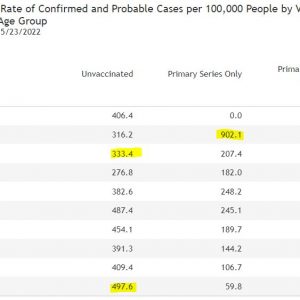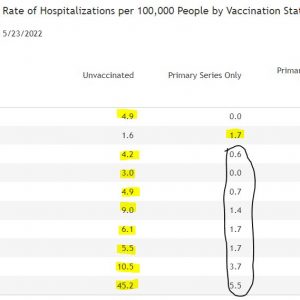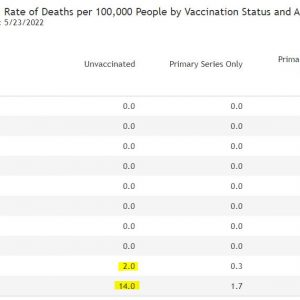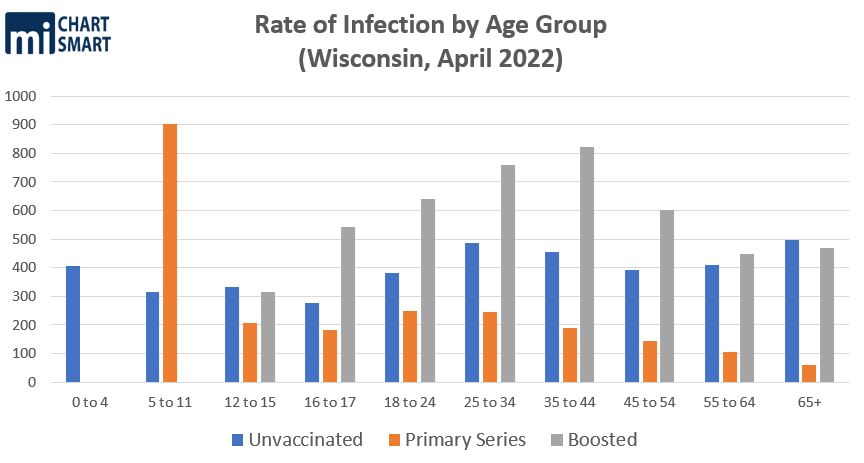
Yet, DHS still wants 5- to 11-year-olds to get boosted.
May 26, 2022 | MacIver News Service
By Bill Osmulski
New data from the Wisconsin Department of Health Services (DHS) might make you think twice about getting a Covid vaccine booster.
DHS updated its “illness after vaccination” webpage on Thursday, May 26th (and backdated it to May 23rd). It includes Covid cases, hospitalizations, and death by vaccination status for April. For the first time, this included outcomes for individuals who received the booster shots.
Vaccinated children aged 5 – 11 are at the highest risk of infection overall. Their rate of infection is 902.1 per 100,000.
The combined data for all age groups shows an infection rate per 100,000 of: 420.8 for the unvaccinated, 211.5 for those with the primary series, and 507 for those who got the booster. Yes, those who received the booster had the highest rate of infection.
In every age group, boosted individuals had a higher rate of infection than those who only received the primary series. In every age group but two, boosted individuals had a higher rate of infection than those who were unvaccinated.
Vaccinated children aged 5 – 11 are at the highest risk of infection overall. Their rate of infection is 902.1 per 100,000. That’s nearly three times the rate of infection as their unvaccinated peers, which is 316.2 per 100,000.
Last month, vaccinated 5- to 11-year-olds were 2.4 times more likely to catch covid than their unvaccinated peers. In March, the rate of infection among children aged 5-11 was 326 per 100,000 if they were vaccinated and 134.7 per 100,000 if they were unvaccinated.
Children aged 5 – 11 were not eligible to receive booster shots in April. However, according to DHS’ latest data, individuals in most other age groups who received the booster are catching Covid at much higher rates than unvaccinated individuals. Children aged 16 – 17 who got the booster are twice as likely to catch Covid as their unvaccinated peers.
The boosters were most affective for individuals 65 and over. They reported a 6% lower rate of infection than their unvaccinated peers. However, their rate of infection was 683% higher than their peers who only received the primary series.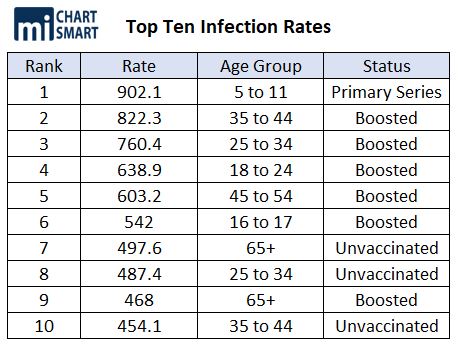
The outcomes were similar for children aged 12 – 15. Their rate of infection was 5% lower than their unvaccinated peers, but 52% higher than those who only received the primary series.
Despite this alarming data about the boosters, both the CDC and DHS are recommending that parents get their children aged 5 – 11 the booster.
In a statement accompanying the new data, said DHS Secretary-designee Karen Timberlake claimed “The COVID-19 vaccines and boosters remain one of the best ways to protect yourself from severe illness, hospitalization, and death due to COVID-19.”
That’s not exactly true. Individuals who received the primary series, but not the booster, were the least likely to be hospitalized with Covid. For children aged 5 – 11, the lowest hospitalization rates were among the unvaccinated.
Also, the risk of dying from Covid for anyone under the age of 55 is practically zero, whether the received the primary series, the booster, or remain unvaccinated. However, boosted individuals above the age of 55 are slightly more likely to die from Covid than their peers who only received the primary series.
All in all, the newest data from DHS makes a strong case against getting the booster shots. And yet, DHS is now recommending children aged 5 – 11 get the boosters.
